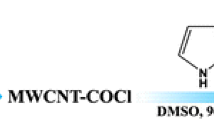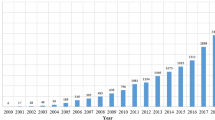Abstract
In the present study, adsorption of lead and cadmium in wastewater was investigated by ethylenediamine-surface-modified single-walled carbon nanotubes (EDA-SWCNTs) to determine important parameters influencing the performance of carbon nanotubes for the adsorption process and to specify optimum values of the parameters in this process. The adsorbents were characterized by Fourier transform infrared spectroscopy, field emission scanning electron microscopy, and energy-dispersive X-ray spectroscopy. At 1 atm, the adsorption capacity of carbon nanotubes was increased (52% for Pb and 72% for Cd) after modification with EDA. The effect of concentration of lead and cadmium ions, the dosage of carbon nanotubes, pH, temperature, time, and interfering ions on the removal of Pb2+ and Cd2+ was studied, and adsorption efficiency was evaluated by atomic absorption spectrophotometer. Central composite design modeling was utilized to ascertain the interaction of operating parameters and determining optimum conditions. Optimization results showed that the most important factors in this adsorption process were initial concentration of lead and cadmium, CNT dosage, time, and pH, respectively. The optimum adsorption capacity was found to be 96.91% and 93.47% for lead and cadmium ions, respectively. These values were obtained at 4 mg/L of the initial concentration of metallic ions, by 200 mg of EDA-SWCNTs, adsorption time of 50 min, and pH level of 5. Results of validation tests showed an acceptable agreement between experimental and predicted data (error 1.25% for Pb and 1.95% for Cd). The equilibrium isotherm study indicated a good conformity with the Langmuir model suggesting a monolayer homogenous adsorption of lead and cadmium onto carbon nanotubes (R2 = 0.999 for Pb and R2 = 0.997 for Cd).














Similar content being viewed by others
References
Agnihotri S, Rood MJ, Rostam-Abadi M (2005) Adsorption equilibrium of organic vapors on single-walled carbon nanotubes. Carbon 43(11):2379–2388
Amiri A, Maghrebi M, Baniadam M, Heris SZ (2011) One-pot, efficient functionalization of multi-walled carbon nanotubes with diamines by microwave method. Appl Surf Sci 257(23):10261–10266
Assi MA, Hezmee MNM, Haron AW, Sabri MYM, Rajion MA (2016) The detrimental effects of lead on human and animal health. Vet World 9(6):660–671
Babel S, Kurniawan TA (2003) Low-cost adsorbents for heavy metals uptake from contaminated water: a review. J Hazard Mater 97(1–3):219–243
Bayrak Y, Yesiloglu Y, Gecgel U (2006) Adsorption behavior of Cr (VI) on activated hazelnut shell ash and activated bentonite. Microporous Mesoporous Mater 91(1–3):107–110
Chen Y, Muthukumar VS, Wang Y, Li C, Krishnan SS, Sai SSS, Venkataramaniah K, Mitra S (2009) Microwave-assisted solid-state grafting of multi-walled carbon nanotubes on polyurethane for the synthesis of a composite with optical limiting properties. J Mater Chem 19(36):6568–6572
Dinh VP, Li NC, Tuyen A, Hung NQ, Nguyen VD, Nguyen NT (2018) Insight into adsorption mechanism of lead(II) from aqueous solution by chitosan loaded MnO2 nanoparticles. Mater Chem Phys 207:294–302
Duruibe JO, Ogwuegbu MOC, Egwurugwu JN (2007) Heavy metal pollution and human biotoxic effects. Int Jou Phys Sci 2(5):112–118
Dyke CA, Tour JM (2004) Overcoming the insolubility of carbon nanotubes through high degrees of sidewall functionalization. Chem-Eur J 10(4):812–817
Foo KY, Hameed BH (2010) Insights into the modeling of adsorption isotherm systems. Chem Eng J 156(1):2–10
Freundlich HMF (1906) Over the adsorption in solution. J Phys Chem 57(1906):385–471
Fu F, Wang Q (2011) Removal of heavy metal ions from wastewaters: a review. J Environ Manag 92(3):407–418
Gauden PA, Terzyk AP, Rychlicki G, Kowalczyk P, Lota K, Raymundo-Pinero E, Frackowiak E, Béguin F (2006) Thermodynamic properties of benzene adsorbed in activated carbons and multi-walled carbon nanotubes. Chem Phys Lett 421(4–6):409–414
Georgakilas V, Kordatos K, Prato M, Guldi DM, Holzinger M, Hirsch A (2002) Organic functionalization of carbon nanotubes. J Am Chem Soc 124(5):760–761
Ghaedi M, Hajati S, Zaree M, Shajaripour Y, Asfaram A, Purkait MK (2015) Removal of methyl orange by multiwall carbon nanotube accelerated by ultrasound devise: Optimized experimental design. Adv Powder Technol 26(4):1087–1093
Godt J, Scheidig F, Grosse-Siestrup C, Esche V, Brandenburg P, Reich A, Groneberg DA (2006) The toxicity of cadmium and resulting hazards for human health. J Occup Med Toxicol 1:22
Gupta SS, Bhattacharyya KG (2012) Adsorption of heavy metals on kaolinite and montmorillonite: a review. Phys Chem Chem Phys 14(19):6698–6723
Hirsch A (2002) Functionalization of single-walled carbon nanotubes. Angew Chem Int Ed 41(11):1853–1859
Ho YS, Wase DJ, Forster CF (1995) Batch nickel removal from aqueous solution by sphagnum moss peat. Water Res 29(5):1327–1332
Hua M, Zhang S, Pan B, Zhang W, Lv L, Zhang Q (2012) Heavy metal removal from water/wastewater by nanosized metal oxides: a review. J Hazard Mater 211–212:317–331
Iijima S (1991) Helical microtubules of graphitic carbon. Nature 354(56):58
Jusoh A, Shiung LS, Noraaini A, Noor MJMM (2007) A simulation study of the removal efficiency of granular activated carbon on cadmium and lead. Desalination 206(1–3):9–16
Kazemipour M, Ansari M, Tajrobehkar S, Majdzadeh M, Kermani HR (2008) Removal of lead, cadmium, zinc, and copper from industrial wastewater by carbon developed from walnut, hazelnut, almond, pistachio shell, and apricot stone. J Hazard Mater 150(2):322–327
Kobya M, Demirbas E, Senturk E, Ince M (2005) Adsorption of heavy metal ions from aqueous solutions by activated carbon prepared from apricot stone. BioresourTechnol 96(13):1518–1521
Koukouzas N, Vasilatos C, Itskos G, Mitsis I, Moutsatsou A (2010) Removal of heavy metals from wastewater using CFB-coal fly ash zeolitic materials. J Hazard Mater 173(1–3):581–588
Kurniawan TA, Chan GYS, Lo WH, Babel S (2006) Physico–chemical treatment techniques for wastewater laden with heavy metals. Chem Eng J 118(1–2):83–98
Lata S, Singh PK, Samadder SR (2014) Regeneration of adsorbents and recovery of heavy metals: a review. Int J Environ Sci Technol 12(4):1461–1478
Li YH, Wang S, Wei J, Zhang X, Xu C, Luan Z, Wu D, Wei B (2002) Lead adsorption on carbon nanotubes. Chem Phys Lett 357(3–4):263–266
Li YH, Ding J, Luan Z, Di Z, Zhu Y, Xu C, Wu D, Wei B (2003) Competitive adsorption of Pb2+, Cu2+ and Cd2+ ions from aqueous solutions by multiwalled carbon nanotubes. Carbon 41(14):2787–2792
Liu Z, Zhong X, Wang Y, Ding Z, Wang C, Wang G, Liao S (2018) An efficient adsorption of manganese oxides/activated carbon composite for lead (II) ions from aqueous solution. Arab J Sci Eng 43:2155–2165
Liu Y, Xiong Y, Xu P, Pang Y, Du C (2020) Enhancement of Pb (II) adsorption by Boron doped ordered mesoporous carbon: isotherm and kinetics modeling. Sci Total Environ 708:134918
Long RQ, Yang RT (2001) Carbon nanotubes as superior sorbent for dioxin removal. J Am Chem Soc 123(9):2058–2059
Lu C, Liu C (2006) Removal of nickel (II) from aqueous solution by carbon nanotubes. J Chem Technol Biotechnol 81(12):1932–1940
Moosavirad SM, Sarikhani R, Shahsavani E, Mohammadi SZ (2015) Removal of some heavy metals from inorganic industrial wastewaters by ion exchange method. J Water Chem Technol 37(4):191–199
Odom TW, Huang JL, Kim P, Lieber CM (1998) Atomic structure and electronic properties of single-walled carbon nanotubes. Nature 391:62–64
Ogden MD, Moon EM, Wilson A, Pepper SE (2017) Application of chelating weak base resin Dowex M4195 to the recovery of uranium from mixed sulfate/chloride media. Chem Eng J 317:80–89
Pillay K, Cukrowska EM, Coville NJ (2009) Multi-walled carbon nanotubes as adsorbents for the removal of parts per billion levels of hexavalent chromium from aqueous solution. J Hazard Mater 166(2–3):1067–1075
Rao GP, Lu C, Su F (2007) Sorption of divalent metal ions from aqueous solution by carbon nanotubes: a review. Sep Purif Technol 58(1):224–231
Sekar M, Sakthi V, Rengaraj S (2004) Kinetics and equilibrium adsorption study of lead (II) onto activated carbon prepared from coconut shell. J Colloid Interface Sci 279(2):307–313
Taamneh Y, Sharadqah S (2017) The removal of heavy metals from aqueous solution using natural Jordanian zeolite. Appl Water Sci 7(4):2021–2028
Uddin MK (2017) A review on the adsorption of heavy metals by clay minerals, with special focus on the past decade. Chem Eng J 308:438–462
Wang YH, Lin SH, Juang RS (2003) Removal of heavy metal ions from aqueous solutions using various low-cost adsorbents. J Hazard Mater 102(2–3):291–302
Weng CH, Huang CP (2004) Adsorption characteristics of Zn (II) from dilute aqueous solution by fly ash. Colloids Surf A 247(1–3):137–143
Yang K, Zhu L, Xing B (2006) Adsorption of polycyclic aromatic hydrocarbons by carbon nanomaterials. Environ Sci Technol 40(6):1855–1861
Zeng D, Dai Y, Zhang Z, Wang Y, Cao X, Liu Y (2020) Magnetic solid-phase extraction of U (VI) in aqueous solution by Fe3O4@ hydroxyapatite. J Radioanal Nucl Chem 324:1329–1337
Zhang Q, Zhang S, Zhang L (2014) Microwave-assisted modification of carbon nanotubes with biocompatible polylactic acid. J Mater Sci Chem Eng 2(1):7–12
Zhu J, Kim J, Peng H, Margrave JL, Khabashesku VN, Barrera EV (2003) Improving the dispersion and integration of single-walled carbon nanotubes in epoxy composites through functionalization. Nano Lett 3(8):1107–1113
Acknowledgements
The authors would like to thank the Karoon Oil and Gas Production Company (Ahwaz, Khuzestan Province, Iran) for supporting this project. They also highly appreciate Dr. Majid Baniadam, at Department of Chemical Engineering, Ferdowsi University of Mashhad (Mashhad, Khorasan Razavi Province, Iran) for his technical information and suggestions through this work.
Funding
The authors certify that they have NO affiliations with or involvement in any organization or entity with any financial interest, or nonfinancial interest in the subject matter or materials discussed in this manuscript.
Author information
Authors and Affiliations
Corresponding author
Ethics declarations
Conflict of interest
There is no conflict of interest concerning this study.
Additional information
Editorial Responsibility: Samareh Mirkia.
Rights and permissions
About this article
Cite this article
Fard, E.M., Parvareh, A. & Moravaji, M.K. Optimization of removal of lead and cadmium from industrial wastewater by ethylenediamine-modified single-walled carbon nanotubes. Int. J. Environ. Sci. Technol. 19, 2747–2760 (2022). https://doi.org/10.1007/s13762-021-03390-3
Received:
Revised:
Accepted:
Published:
Issue Date:
DOI: https://doi.org/10.1007/s13762-021-03390-3




